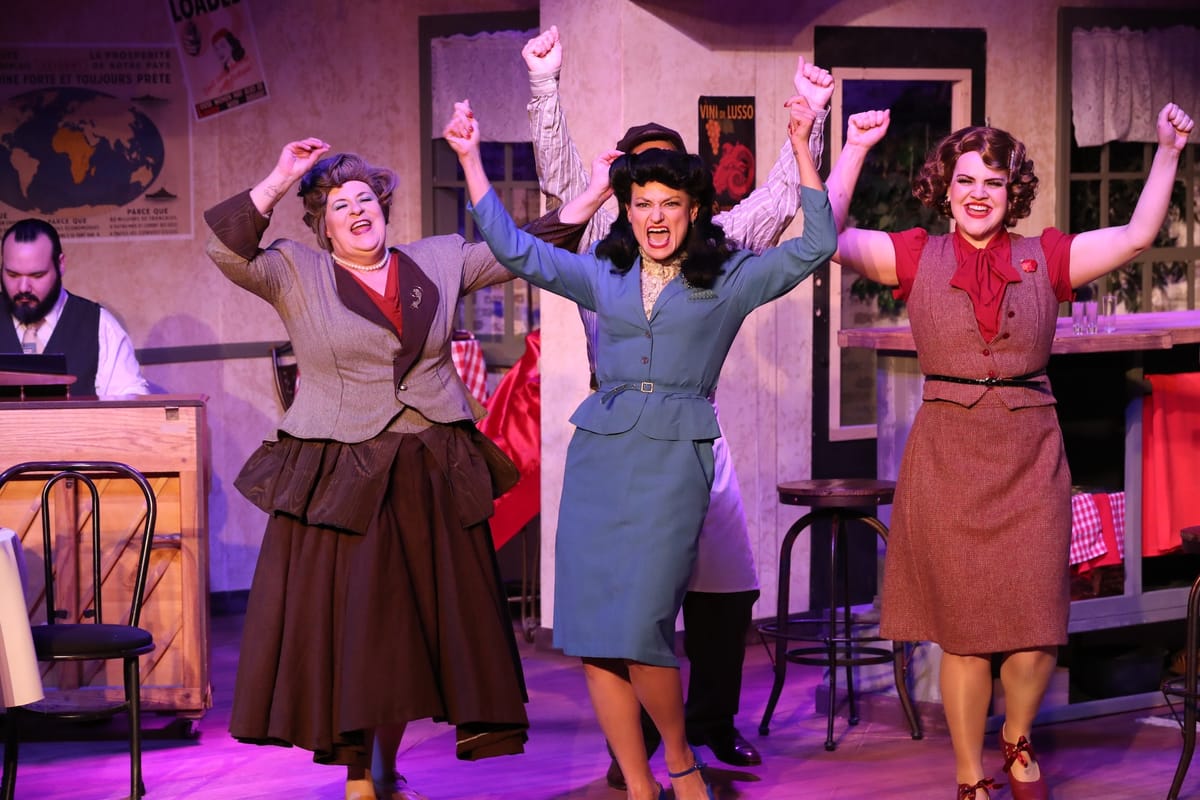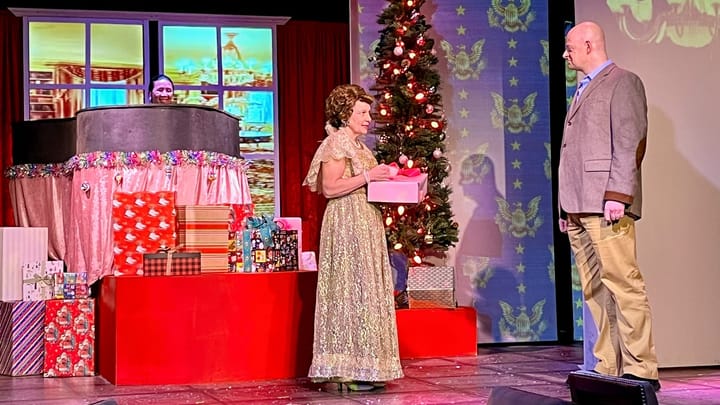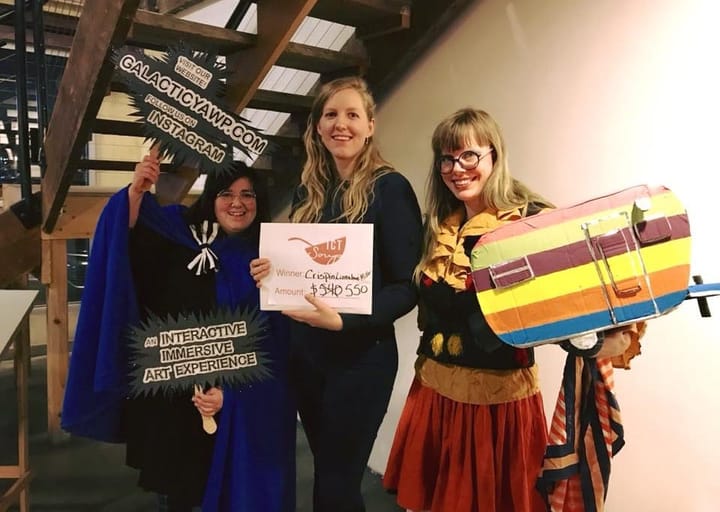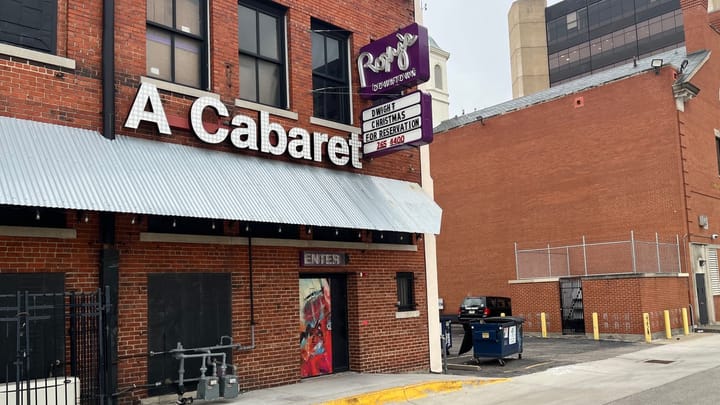Music Theatre Wichita’s longest-serving employee celebrates 50 years of curtains
Among (many) other contributions, Mary Sue Dymak helped build the production company’s robust theatrical rentals program.

There’s a saying: If you want something done, ask a busy person.
For 50 years, Mary Sue Dymak has been that person for Music Theatre Wichita. As the rentals and inventory director, she oversees more than 50,000 square feet of warehouse space and manages the logistics of shipping truckfuls of scenery and costumes to theaters around the country.
That’s among the other duties she’s picked up over the years.
Since 1976, the summer after her freshman year at Friends University, Dymak has had a hand in nearly every aspect of the theater’s production process. She is also the unquestioned keeper of institutional memory for one of Wichita’s largest arts organizations.
“Anything I ask, I know it’s going to be met with truth backed up by years and years of historical knowledge,” said Brian J. Marcum, who succeeded Wayne Bryan as the company’s artistic director.
She’s like nobody I’ve ever met,” said Bryan, who led MTW for more than 30 years. “She’s so multi-faceted. She’s incredibly bright, she’s incredibly musical … She can come off all business, and can even be frightening to some people, but she's really quite warm.”
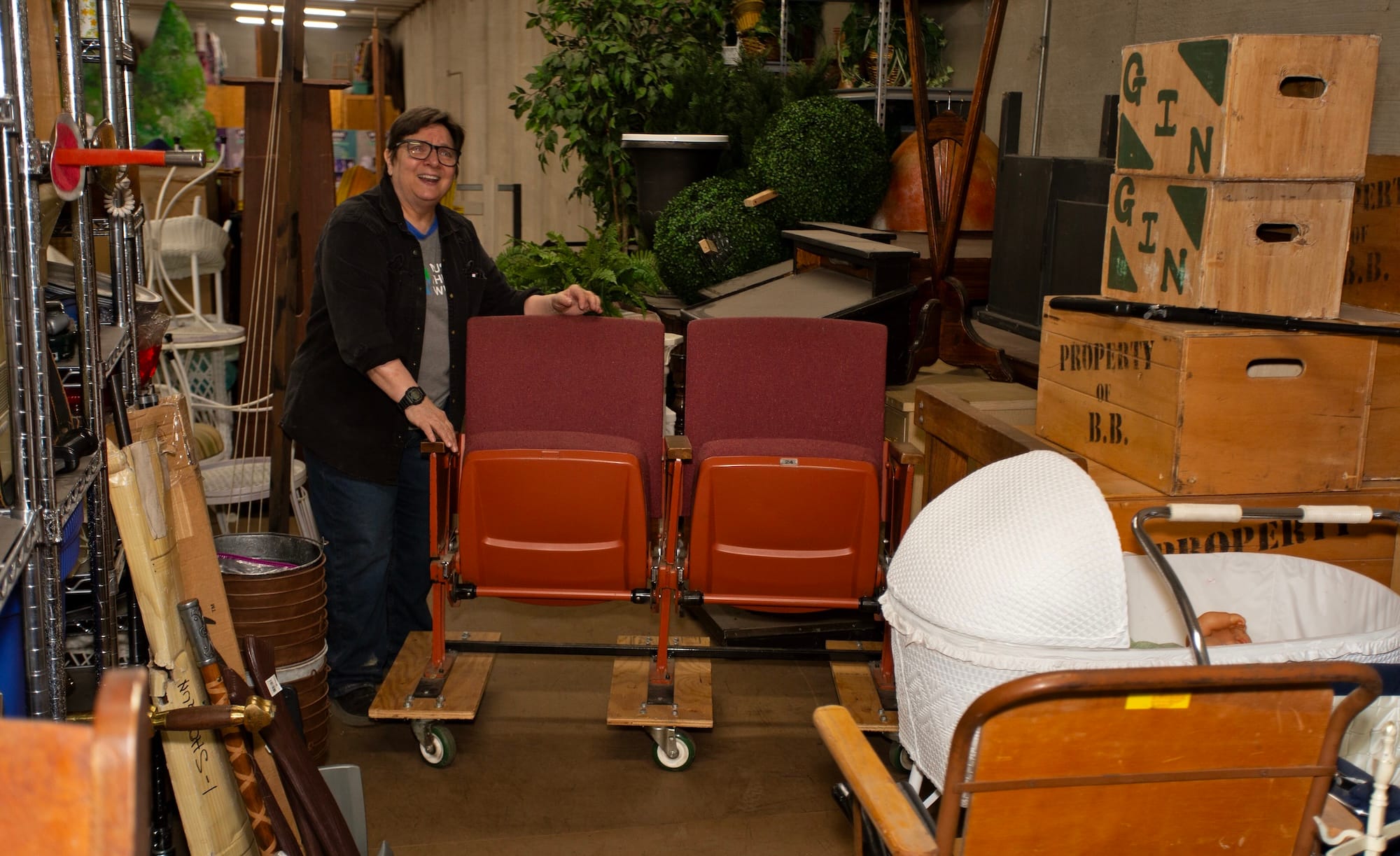
When Bryan assumed leadership of the organization in 1988, Dymak had already established herself in the back corner of the rehearsal room in the Century II basement. That’s where she still sews and finishes backdrops from giant strips of muslin fabric, each 10 feet wide and 55 feet long, using a Consew industrial machine. She learned the job through “a lot of trial — I couldn’t afford much error.”
Like Marcum after him, Bryan leaned on Dymak’s knowledge of the organization and its processes.
“She could not only tell me the technical things, but she could give me clues into the personalities or the history of Music Theatre Wichita, all those kinds of things that helped me understand the community,” Bryan said.
Subscribe to our free email newsletters
Stay in the know about Wichita's arts and culture scene with our Sunday news digest and Thursday events rundown.
No spam. Unsubscribe anytime.
At that time, the company was in its second decade of producing five musicals every summer season with just four full-time employees.
“The scenery that was built each summer was built to fulfill one week of performances, but wasn't built to last longer than that,” Bryan said. “Everything was thrown out at the end of each summer.” The only exceptions were costumes that MTW stored in cardboard wardrobe boxes in the attic space of a patron’s business.
In Bryan’s first season as artistic director, MTW sold their “Camelot” set to the Santa Barbara Light Opera. “That opened the door to more interactions with other theaters around the country.” Bryan realized that Wichita's relatively inexpensive real estate posed an opportunity for the organization.
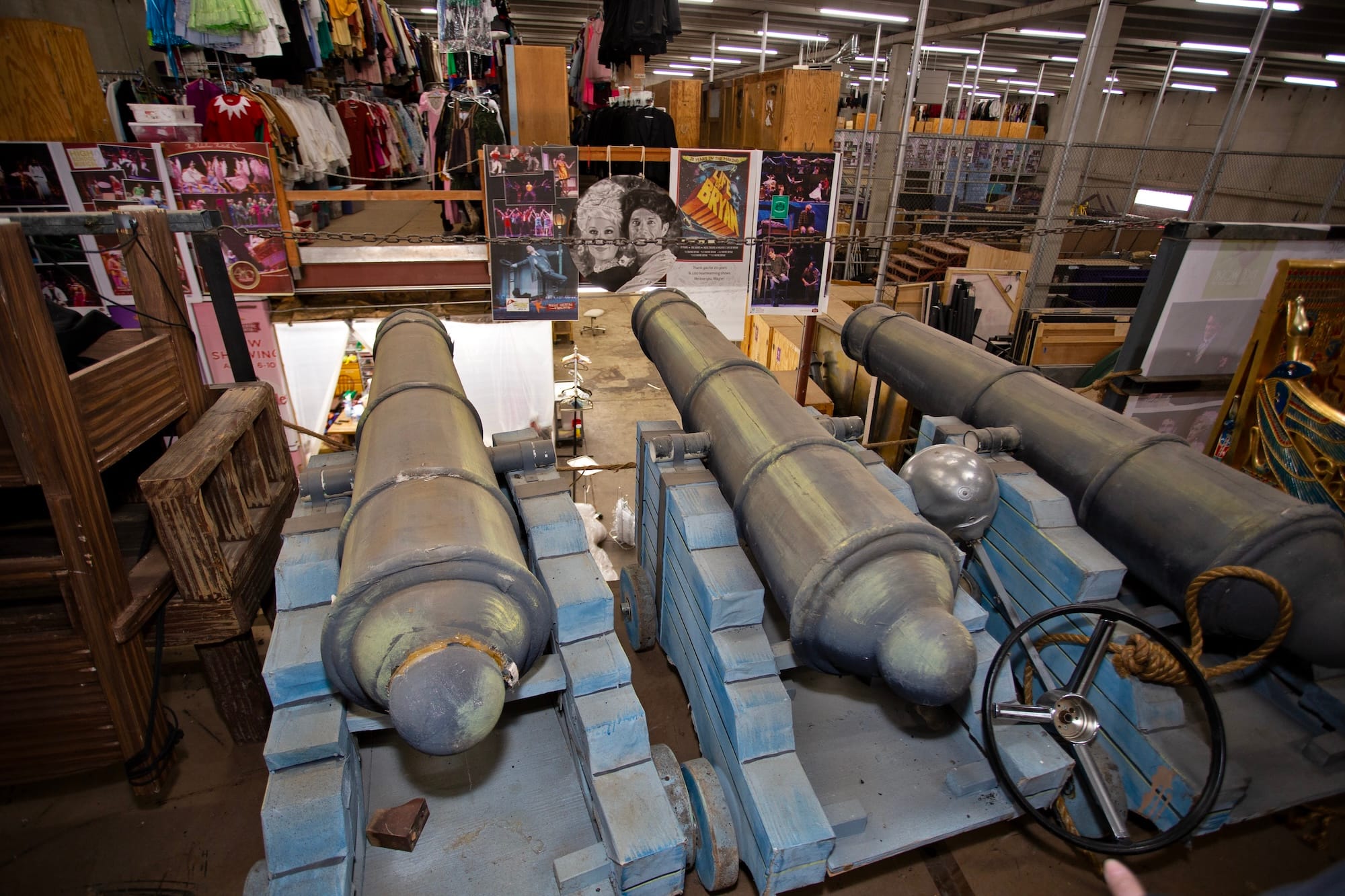
By the mid-90s, “We started to strategize about how we could turn the rentals aspect of our scenery and costumes into some kind of business,”he said. The expansion also enabled him to offer Dymak a full-time job.
"The rentals program has helped MTWichita’s reputation enormously, and it made it a more desireable place for people to come and work in the summer." — Wayne Bryan, former artistic director, Music Theatre Wichita
Soon, storage became a major concern. For a while, the company rented a series of units. “I walked around with the keys to 14 padlocks,” Dymak said.
She found MTW’s first warehouse when she noticed a realty sign on a building on Washington Street in Wichita’s industrial district. The 19,500-square-foot, two-story space now holds a big chunk of the organization’s inventory of scenery, costumes, and props.
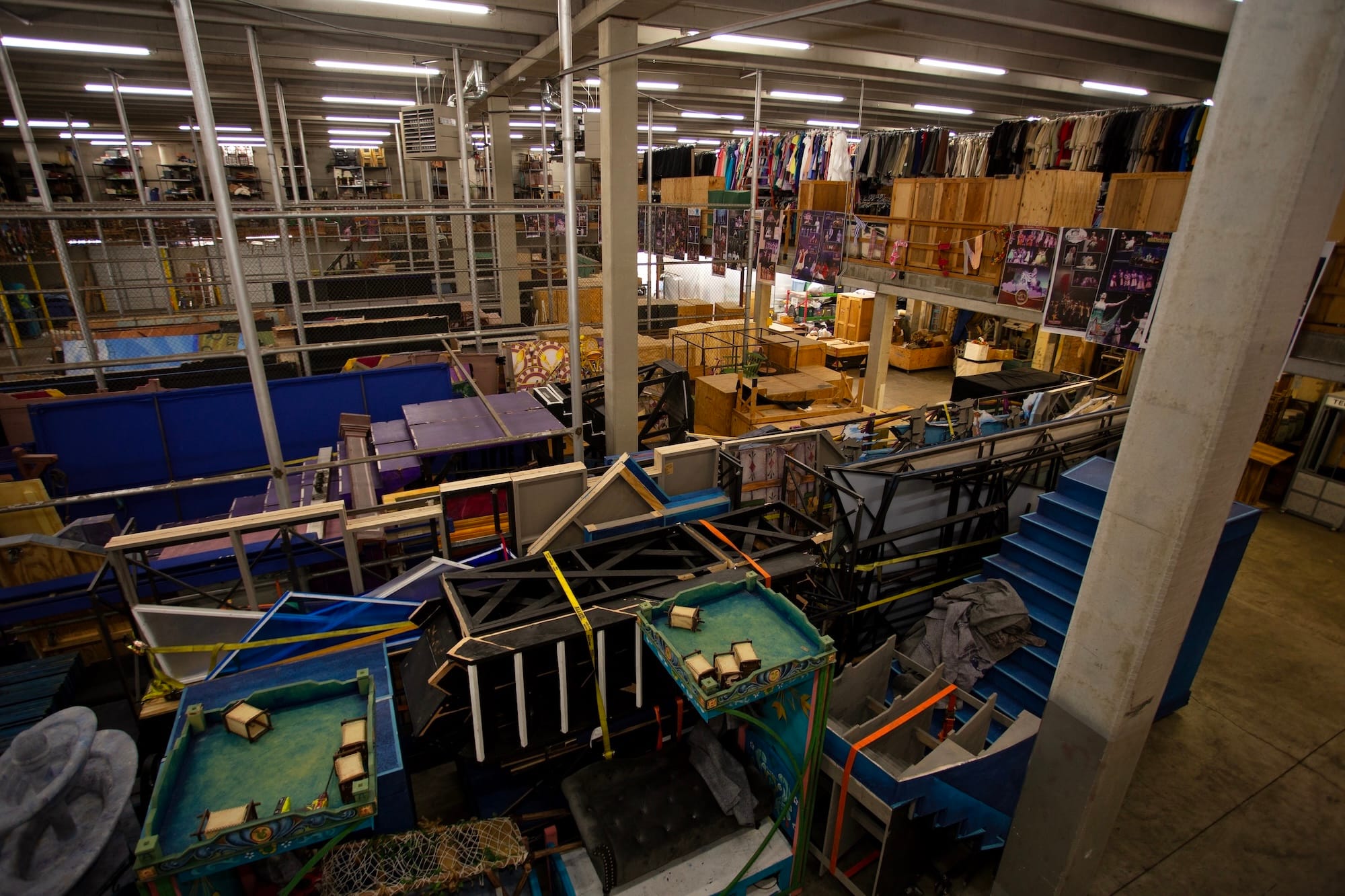
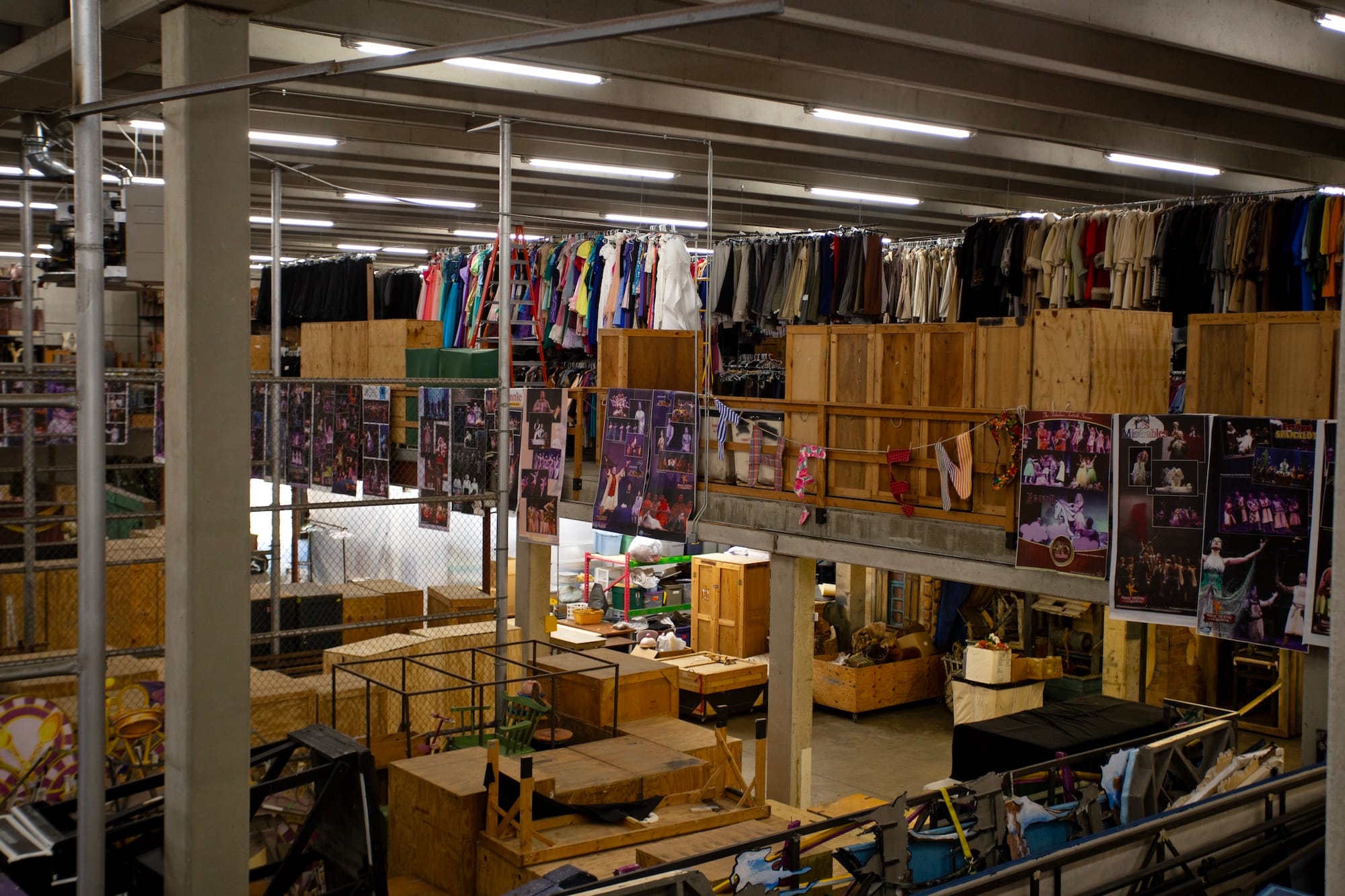
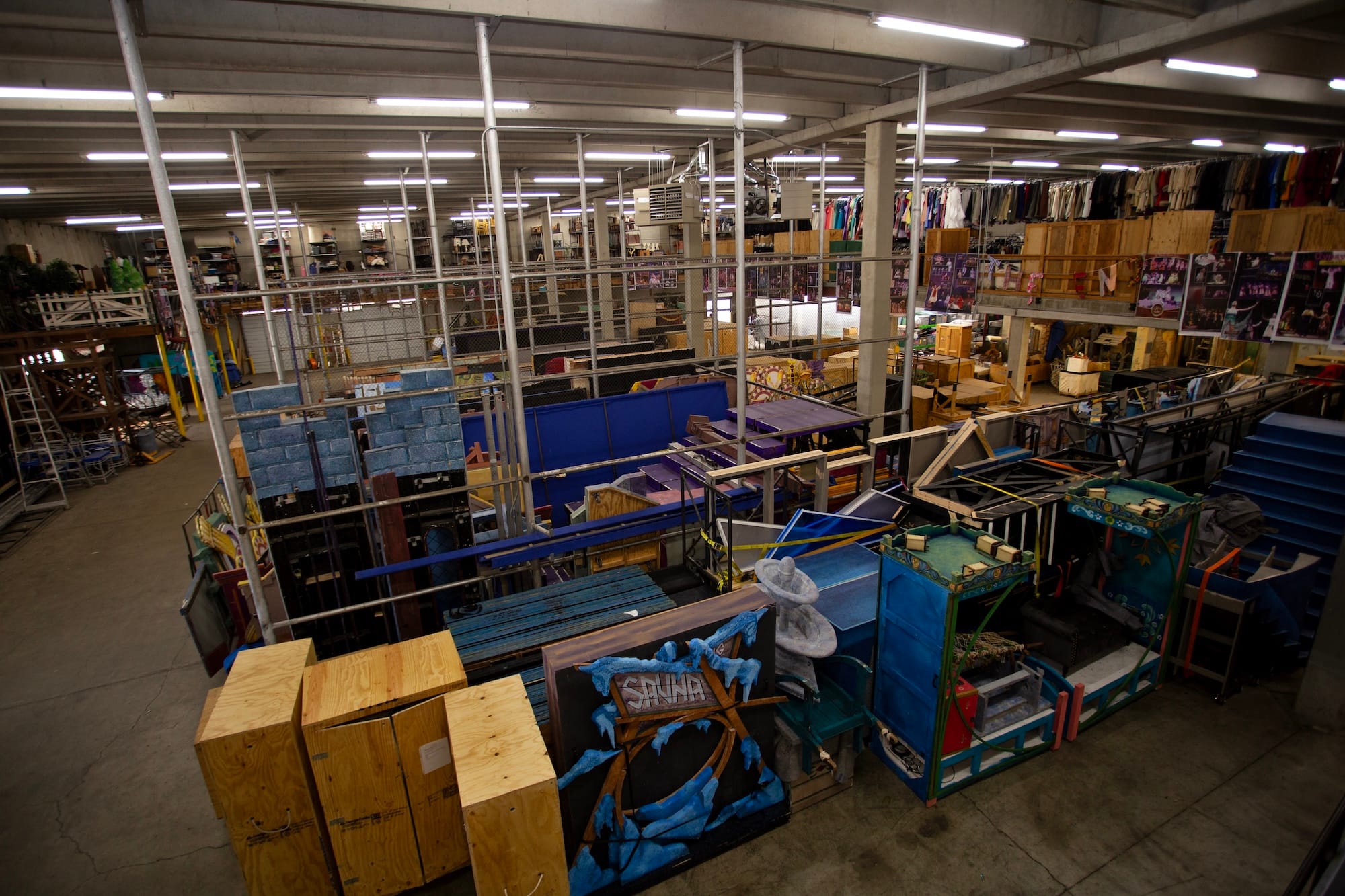

Second-floor mezzanine views from Music Theatre Wichita's Washington Street warehouse. Photos by Jason Crile for the SHOUT.
“The warehouse is a living, breathing thing,” Dymak said. “And it’s my job to know where everything is.”
Dymak and Jacob Locke, MTW’s costume coordinator and second-in-command on the rentals team, use the Washington Street location to process scenery, props and costumes. (MTW purchased a second, larger warehouse in 2017 after renting it for two years. It holds all of the company's scores, scripts, and orchestrations, plus 11 whole "packages" — scenery, props, and costumes for an entire musical production.) They have a washer, dryer, and sewing machines on the premises. While prepping for the summer season at the end of May, the to-do list also included checking in a cache of rental costumes another theater had recently returned.
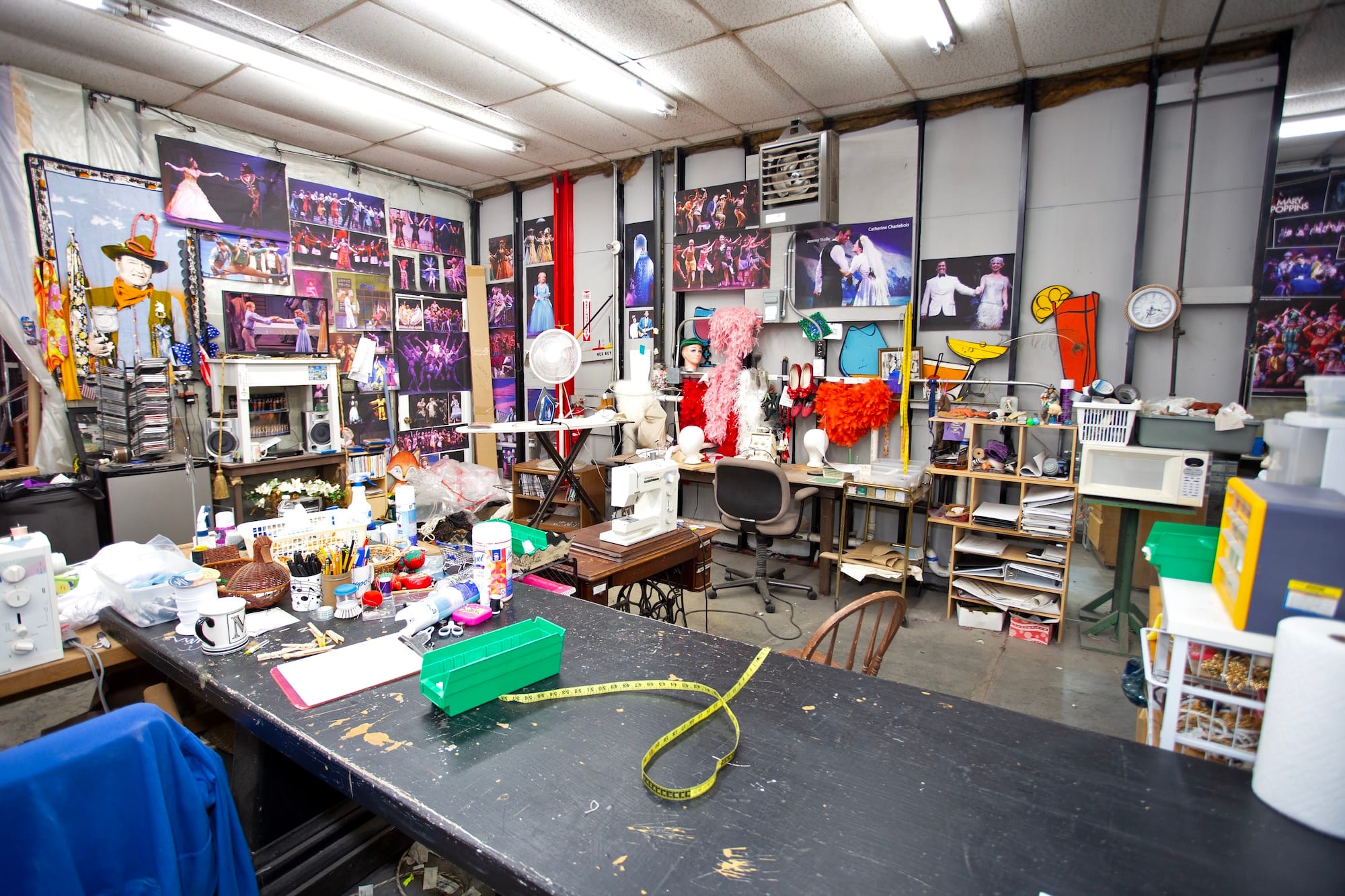
Locke has worked with Dymak for 10 years, and, like many of her colleagues, he emphasizes both her work ethic and her love of the performing arts.
“She has a beautiful soul,” he said. “She loves things like opera and orchestra music. She’s such a hard worker you might not guess that she has such a deep understanding of music and theater.
“She takes that passion and turns it into work. She’s like a little coal furnace.”
Mary Sue Dymak and Jacob Locke filmed a warehouse walkthrough during the COVID pandemic that highlights both the MTW inventory and their personalities. (Music Theatre Wichita via YouTube.)
The Washington Street building is a testament to MTW’s penchant for reuse and preservation. The shelves holding props on the second-floor mezzanine were made from old scenery. “When we got rid of Camelot, we used those frames, put connectors on them, put plywood on them, and bingo — shelves,” Dymak explained.
The elevator used to move costumes and props between floors was also scavenged from a set: MTW acquired it from Bob Fosse’s “Sweet Charity” tour before repurposing the piece.
The COVID pandemic temporarily halted the rentals program, but Dymak and Locke kept working. They spent weeks organizing the company’s collection of backdrops for an online catalog that theaters can browse. In her typical fashion, Dymak sewed and stenciled the canvas storage bags.
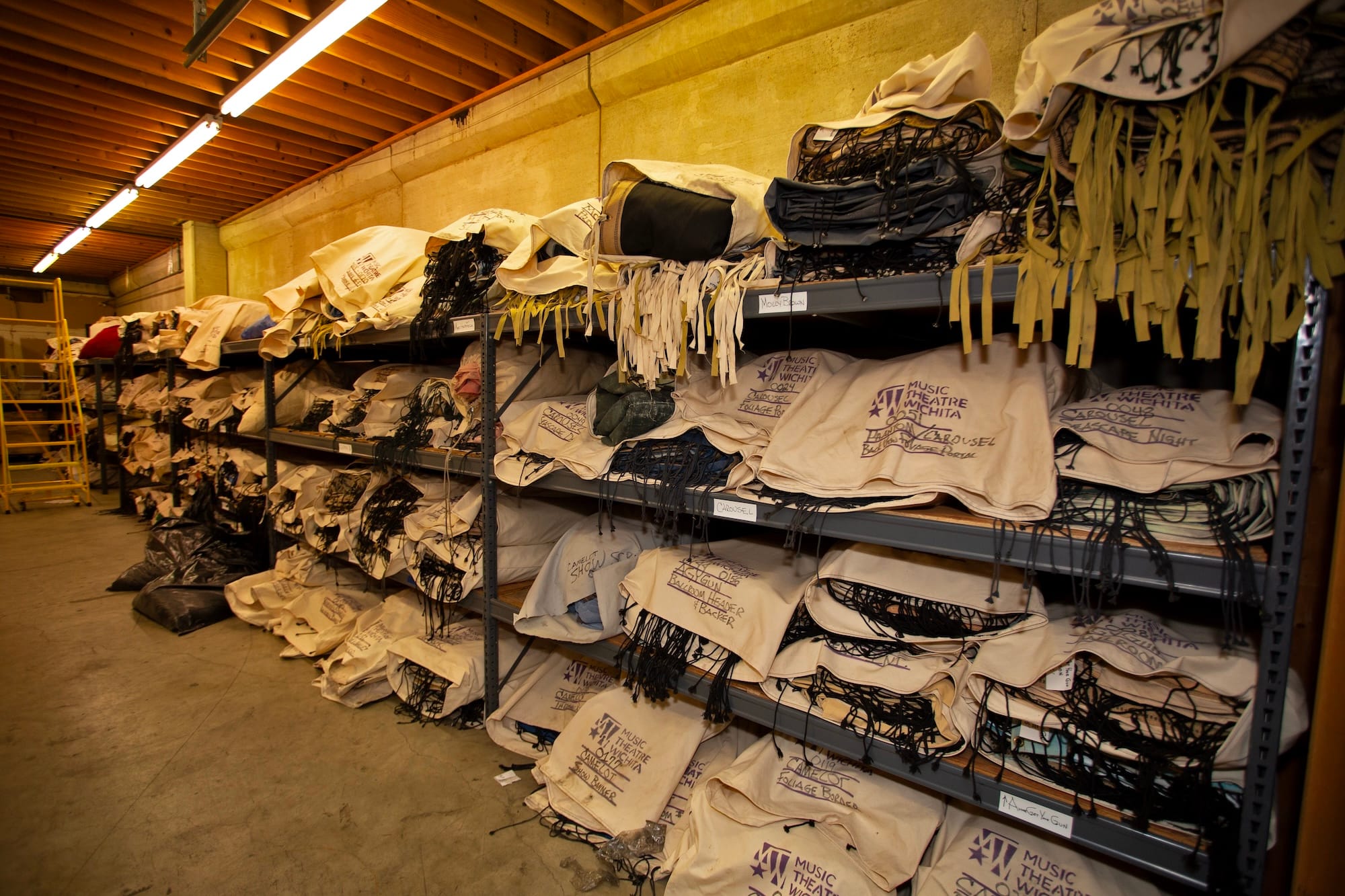
For many years, rentals reliably contributed about 10% to the MTW budget. That has changed since the pandemic, partly due to theater closures and also because the MTW budget has grown, said Angela Cassette.
An abbreviated list of jobs Dymak has done for MTW over the years includes: property manager, orchestra manager, shopper/buyer, and video archivist. Not to mention performer: She has appeared in numerous MTW shows over the years, including as Fruma-Sarah in “Fiddler on the Roof,” the mayor of Munchkinland in “The Wizard of Oz,” and an accordion player on stage in “Cabaret.” (Bryan: “She’s a woman of constantly surprising talents.”)
Like many arts workers, Dymak also spent a long stretch of her career bouncing from one gig to the next. These included lead singer at St. Mary’s Cathedral (“about 26 years — that’s a lot of ordinations”), as a stage manager for the Wichita State opera program, and as a stage manager for the Wichita Symphony Orchestra. Before joining the MTW staff full time in 1993, she worked full-time at Theatrical Services International, where she also worked on drops and draperies.
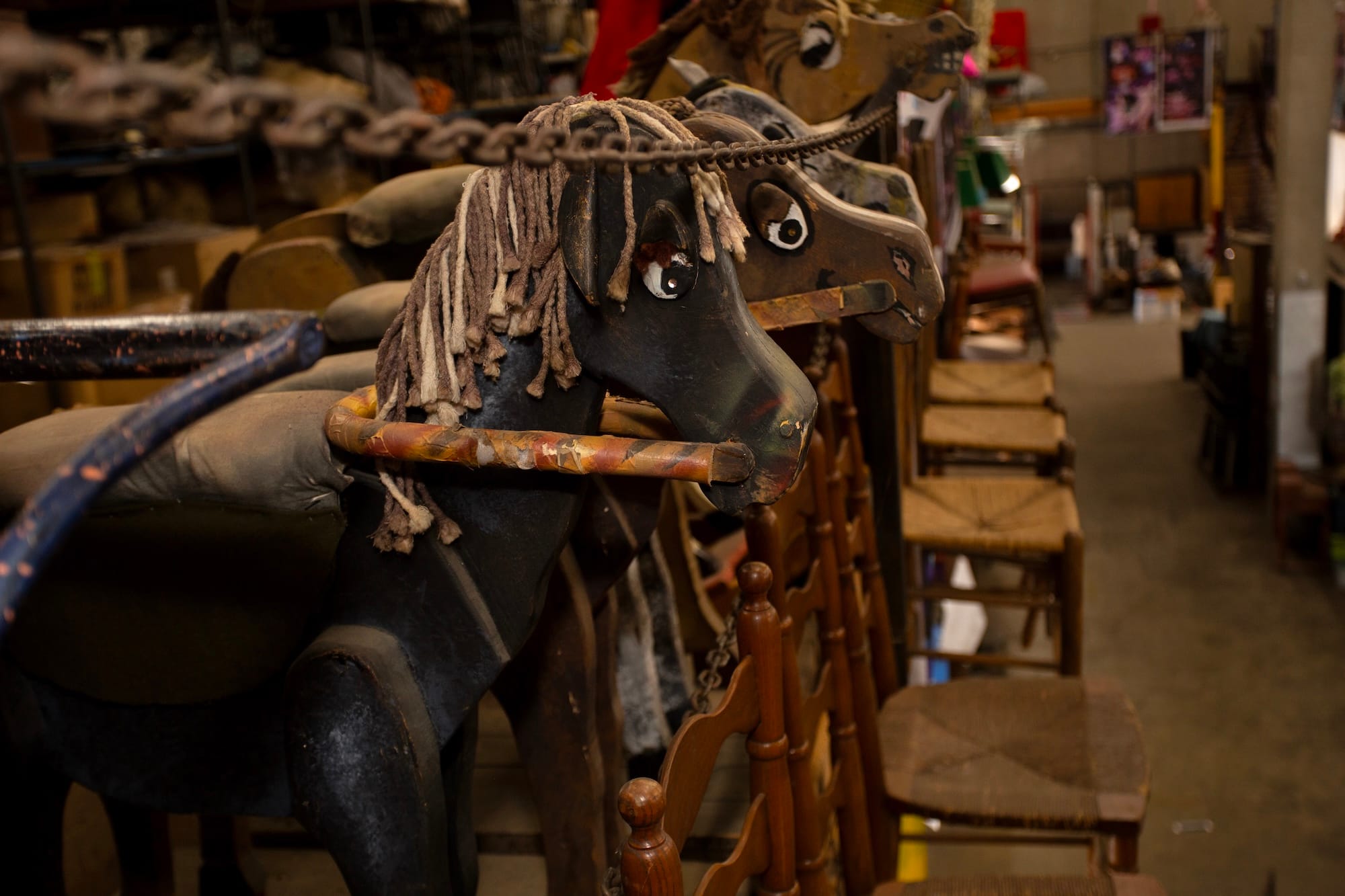
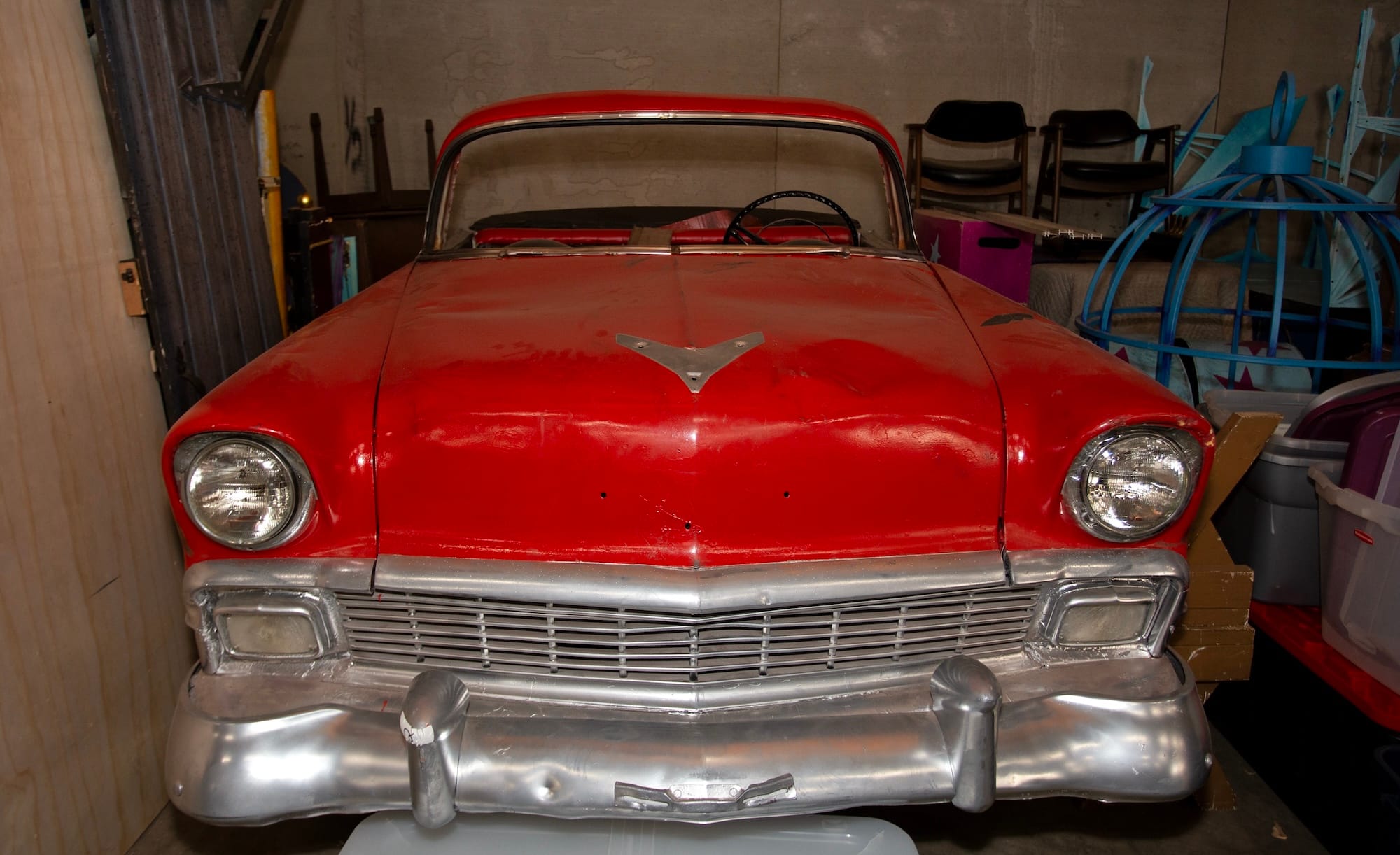
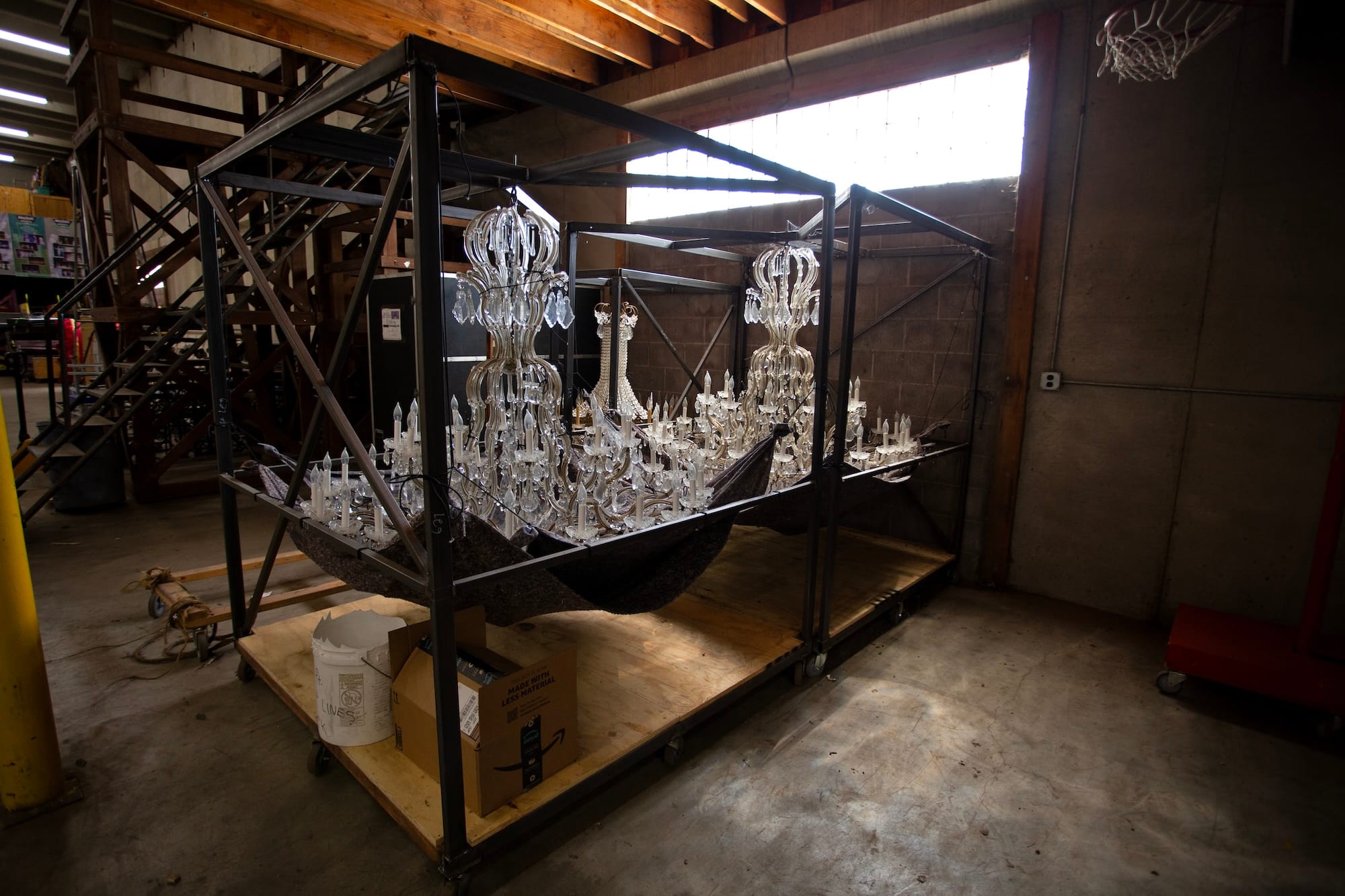
A few of the treasures in one of Music Theatre Wichita's warehouse: rocking horses from the 1989 production of "Tintypes," the car from "Grease," and a trio of chandeliers. Photos by Jason Crile for the SHOUT.
Dymak still coordinates the musicians in the orchestra pit, and she still films each show for the MTW archive. And she still thrives on the chaos of producing five shows a season.
“It's multitasking in its craziest form,” she said. And she somehow manages to keep herself just organized enough to pull it off — a skill she attributes to her background in stage management.
“You just do it. I don't know how else to describe it,” she said. “I never took a stage management class. I never read a book on stage management. You just learn to see and understand what works and how it works.
“And boy howdy, did I get that from my parents.”
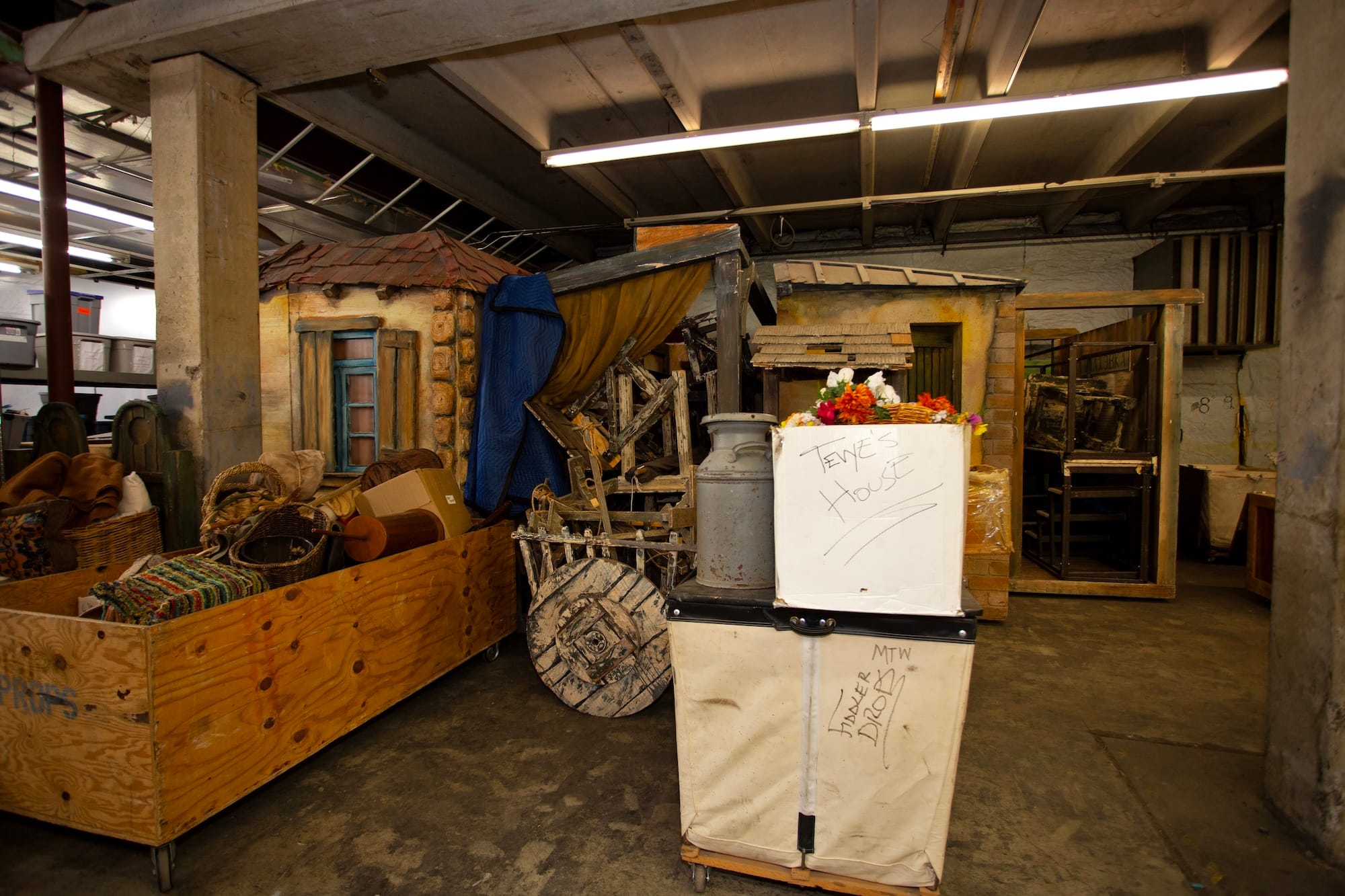
They met when her mother was working in Omaha as a traveling nurse during a flu epidemic. Her father worked for the supermarket chain Safeway for 44 years, first as a night clerk stocking shelves and eventually as a construction engineer who retired as a vice president. He was once coaxed out of retirement to spend 22 months in Saudi Arabia, overseeing the construction of a Safeway store in Riyadh.
“My dad had to go to Saudi Arabia and figure out how to get grocery carts over there,” Dymak said. She later called on that expertise for her job in the theatrical rental business. She remembers asking for advice about how to approach an international rental on a visit to her parents’ home.
“I had no idea how to broker, who to call, what size containers were allowed, how they were packed,” she said. “Dad and I sat at the dining room table one night and talked for three hours about shipping.”
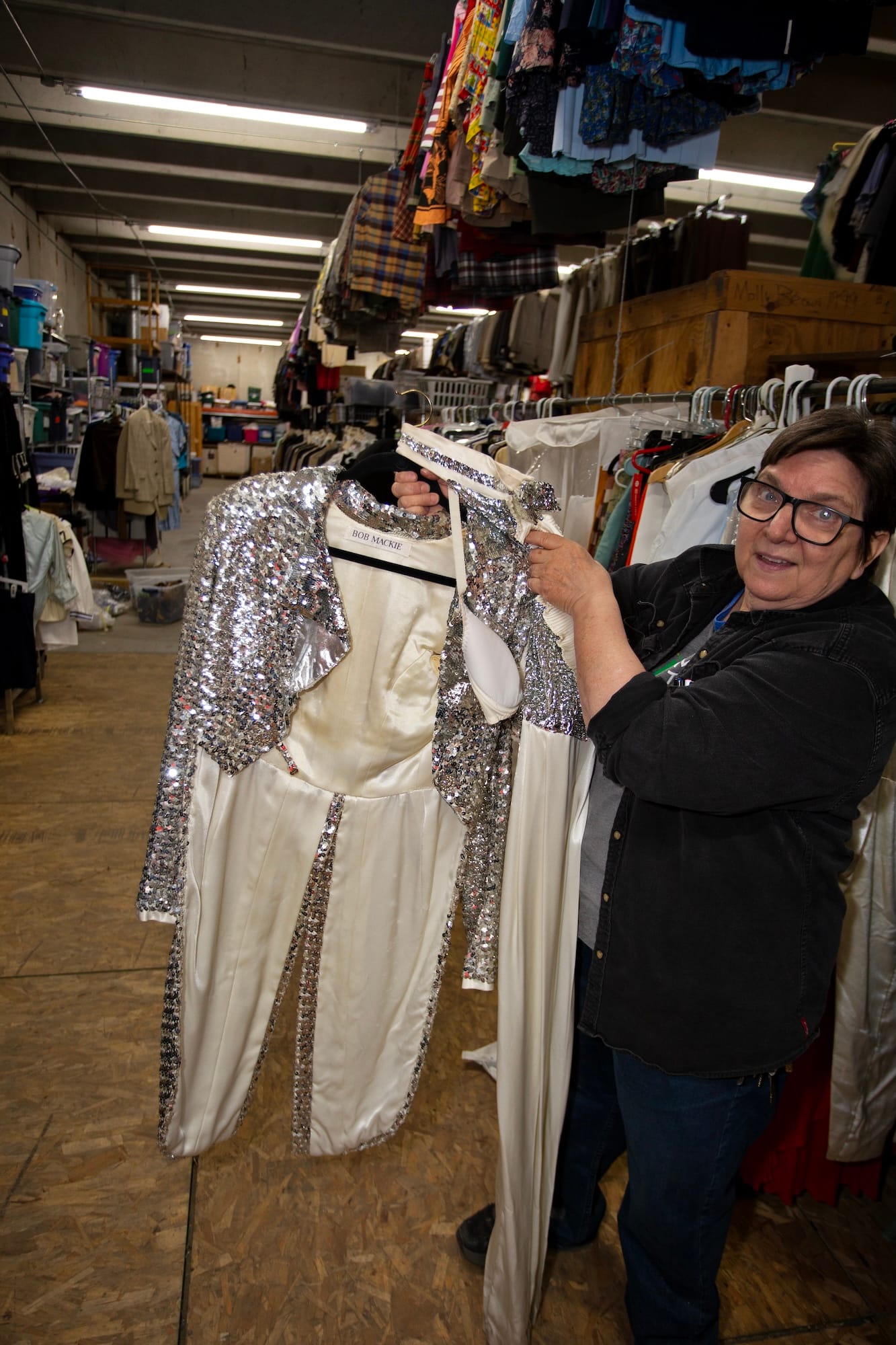
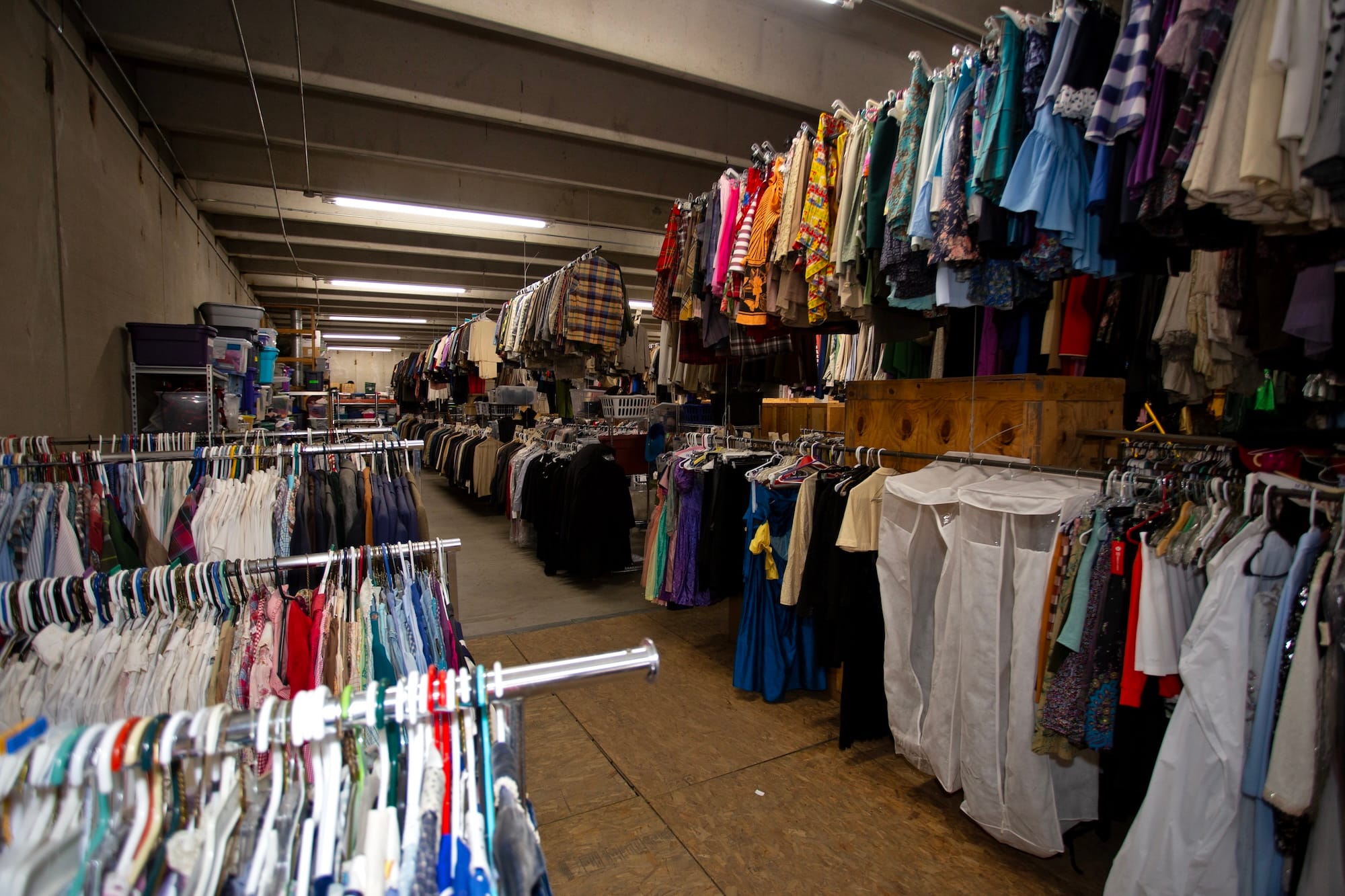
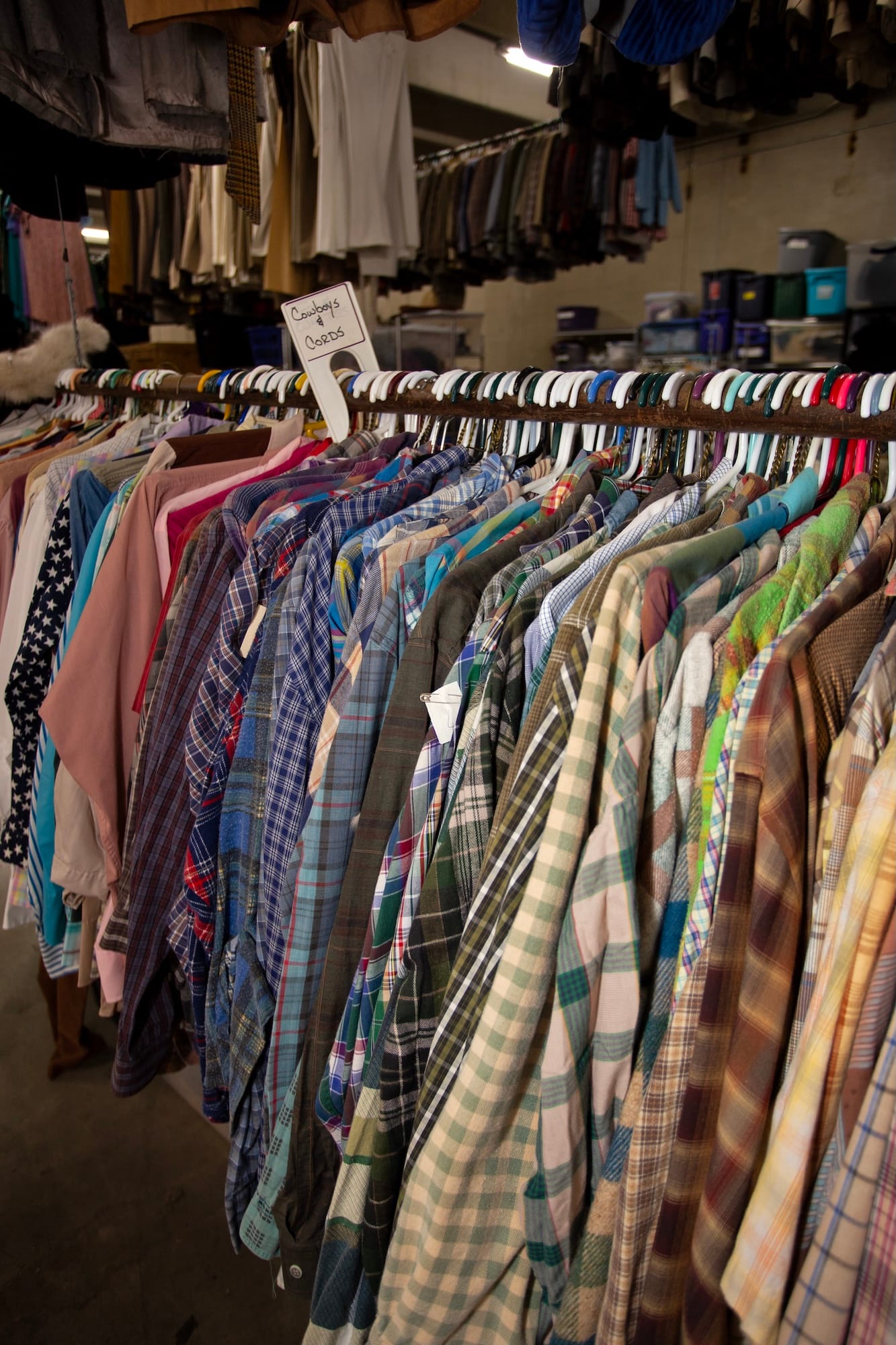
Music Theatre Wichita's Washington Street warehouse includes 1,000 feet of pipe holding hundreds and hundreds of costumes. While mostly designed and sewn in Wichita, they include costumes acquired from other theaters and a few Bob Mackie designs donated to the theater by Toni Kaye, who wore the costumes on "The Carol Burnett Show." Photo by Jason Crile for the SHOUT.
Dymak was born in Omaha, the granddaughter of pioneers on her mother’s side and Czech and Austrian immigrants on her father’s. Her maternal grandfather built a sod house in the early 1900s that’s still standing. (“It is a beautiful piece of construction and engineering.”) Her paternal grandfather was a shoesmith.
“I would sit on a stool beside all of his equipment and just watch him work heavy-duty machines. Maybe that's where I got my love for this,” she said, patting her Consew machine.
She and her siblings spent summers on the family farm with their aunt Mae and uncle Vernon, two other major figures in her life. Family legend has it that Vernon’s parents worked for legendary Western showman Buffalo Bill.
“Sawdust is in my blood,” joked Dymak, whom Cassette calls “a classic theater person.”
“Mary represents the flexibility and determination that theater builds,” Cassette said. “We are constantly problem-solving and brainstorming, and she loves that.”
All of it — even “the boring parts.”
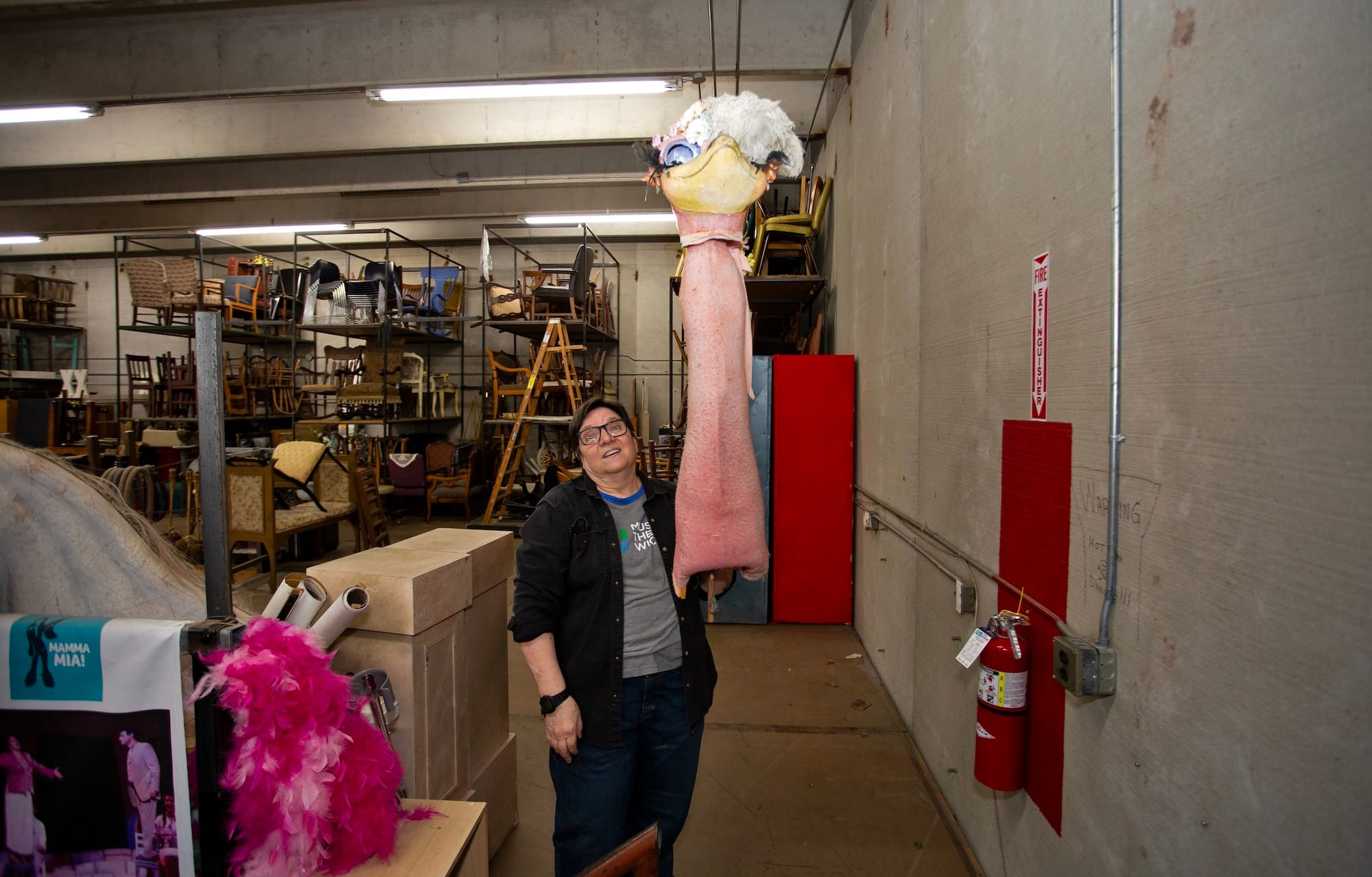
“People ask me what the favorite part of my job is, and I usually say whatever I'm doing at the moment,” Dymak said. “If I'm building a drop, oh my God, I am zenning. I have the machine going, it's humming, I'm pushing fabric through, and I know I'm creating something. Or I'm loading the orchestra into the pit after the orchestra read, and I know that I have a responsibility to make sure that all my players get all of their equipment in safely, in the right position, and plugged in. Or I'm packing a truck from a rental, and I know I have to play a giant game of Tetris. I am putting something on the truck, and I see, oh, there's that much room. Okay, that piece next, then this piece.
“It's the sense of accomplishment, knowing that you've been a part of the creative process. And that's the thing that still to this day fascinates me.”
Emily Christensen is a freelance journalist and one of the co-founders of the SHOUT. She is a past fellow of the National Critics Institute at the Eugene O'Neill Theater Center and a recipient of an Arts Writing Grant from The Andy Warhol Foundation.
Support Kansas arts writing!
The SHOUT is a Wichita-based independent newsroom focused on artists living and working in Kansas. We're partly supported by the generosity of our readers, and every dollar we receive goes directly into the pocket of a contributing writer, editor, or photographer. Click here to support our work with a tax-deductible donation.
⊛ Off-Broadway, a Kansas playwright meditates on the labor that defines us
⊛ Wayne Gottstine is 'back in the fight'
⊛ Star of MTW's 'Gypsy' finds purpose both on stage and from behind a pulpit
⊛ 'You don't have to give up': Clark Britton on making art into his 90s
⊛ Bygone Friends University museum housed curious collections
The latest from the SHOUT
 The SHOUTLeslie VonHolten
The SHOUTLeslie VonHolten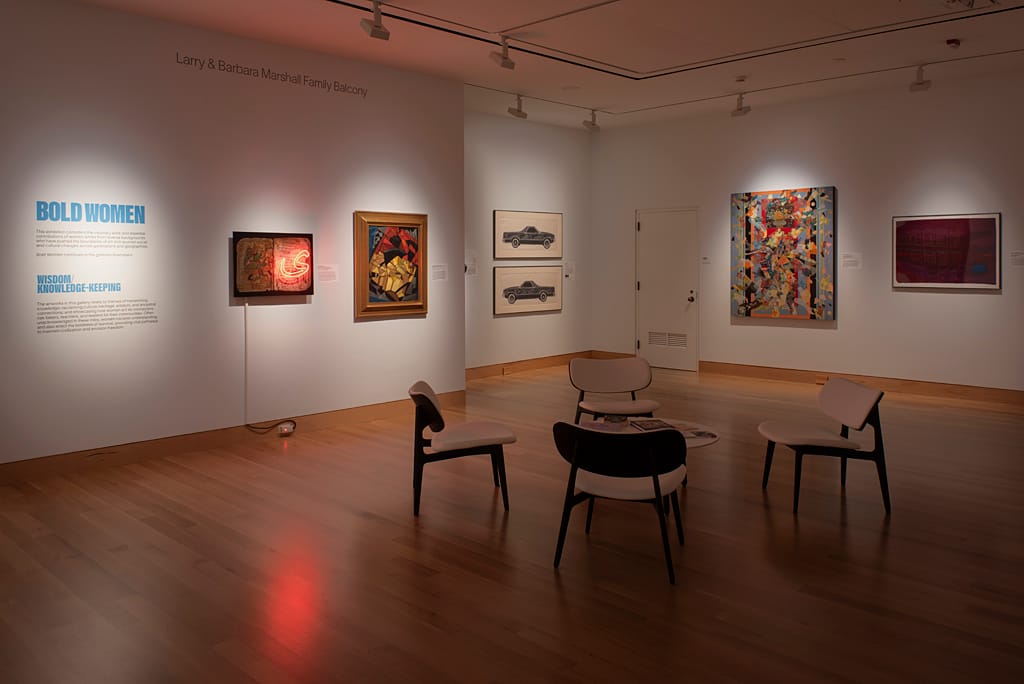
 The SHOUTAnne Welsbacher
The SHOUTAnne Welsbacher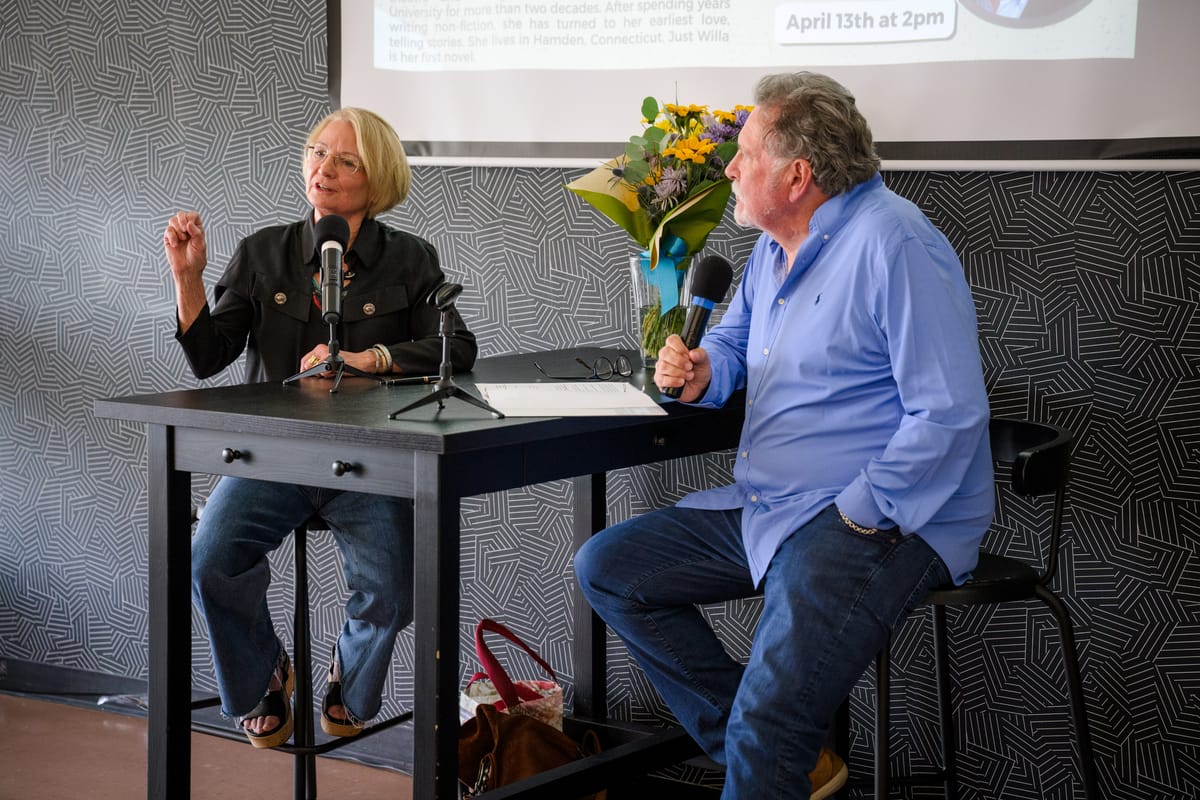
 The SHOUTSam Jack
The SHOUTSam Jack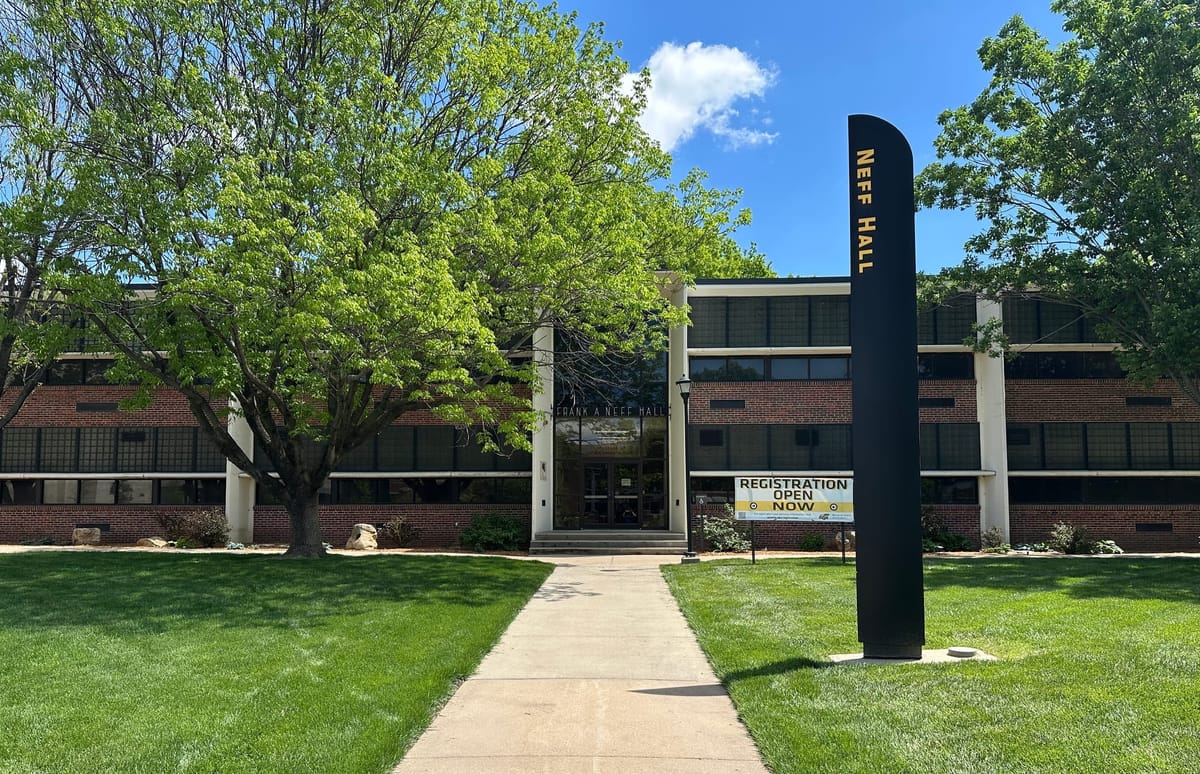
 The SHOUTTeri Mott
The SHOUTTeri Mott